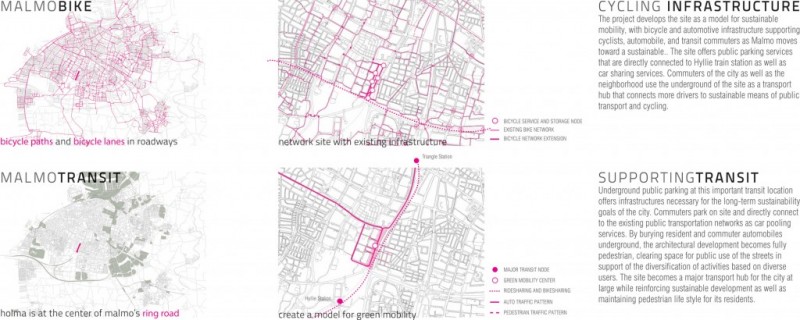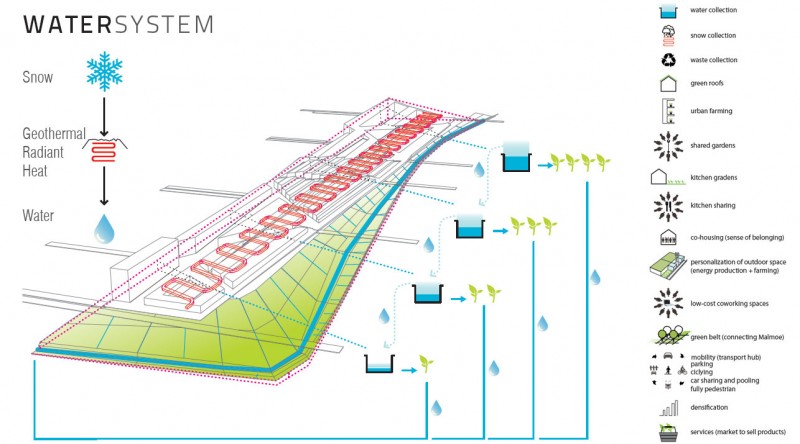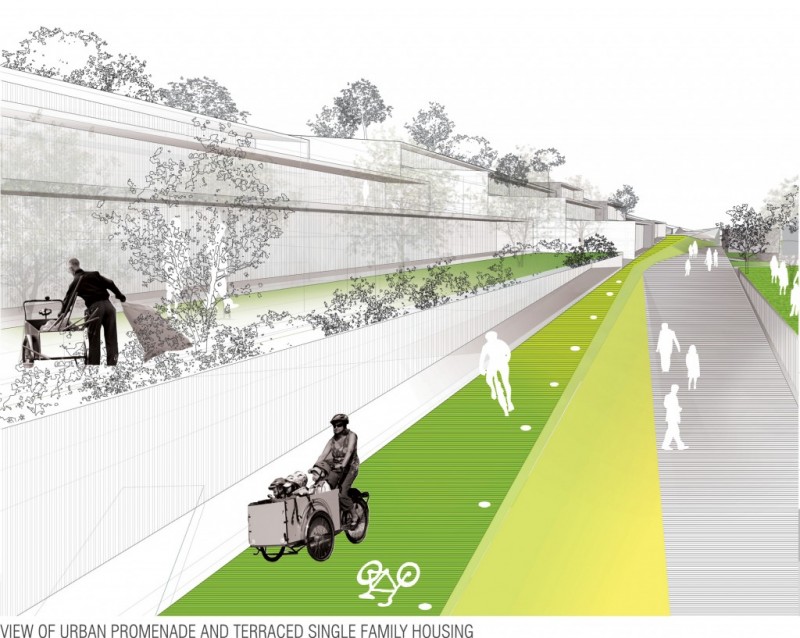Green Mobility_Malmö
::EUROPAN 11 – The Social City – Malmö::

EXISTING ENVIRONMENT
Residents of Holma and vicinity live in varying relationships with nature. The existing architectural environment, as a response to individual development needs, results in different levels of engagement with natural weather patterns and the outdoors. A close analysis of the specific ratios of built environment versus its surrounding green spaces results in patterns that were used as mixing formulas for the proposed project. In general, low density structures enjoy more outdoor green spaces than high density buildings. ‘Green Mobility’ uses a comprehensive matrix of decisions where all levels of densities are supported by outdoor green spaces that directly respond to its user’s lifestyle.
Awards: -
______________________________________________________
Location: Holma area, Malmö (Sweden)
______________________________________________________
Description: sustainable residential development for the eastern part
of Holma: 1000 Living Units; Parking; Social Center
______________________________________________________
Client: MKB Fastighets AB and Riksbyggen, housing companies
______________________________________________________
Role: design team leader
______________________________________________________
Budget: – €
______________________________________________________
Surface: 9 ha
______________________________________________________
Year: June 2011
______________________________________________________
With: Loris Rossi, Giacomo Ortenzi; A G E N C Y (Ersela Kripa,
Stephen Mueller).
Collaborators: Marta Di Vincenzo, Marco Marchionne, Carla Gerundino.
______________________________________________________
Featured in: -
______________________________________________________
Related links: europaconcorsi
______________________________________________________

CONNECTING VISTAS
Flatness characterizes Malmo’s topography. The new hills of Holma connect the inhabitants with the rest of the city through scenic views from strategic heights on the site. On the west side of the ‘Strategic Site’, artificial hills successfully offer views and green space for activities. We capitalize on this strategy by raising the project site, sculpting building and land form to create visual and spatial connections between the inhabitants of Holma with the rest of the city.





INFRASTRUCTURES AND PARKING – INTERNATIONAL TRANSIT CENTER
International and national transit is increasingly becoming an important part of our daily lives. As job markets navigate fluidly across international boundaries, commuting is constantly in need of rethinking its temporal boundaries as well.
‘Green Mobility’ breaks the boundaries between different modes of transportation to provide a comprehensive system of scales, time duration, and customizability.
The new combination of pedestrian, bicycle, car sharing, private and public transport re-establishes transit as a contributing factor to mental and physical health. In ‘Green Mobility’ the residents can walk to their bicycle, exchange it for their time share in an automobile, or take public transportation.
Transit Culture museums throughout the Scandinavian region offer a record of the development of transportation innovations throughout history. By creating a Transit Museum at the intersection of all circulation and access paths on the site, Holma becomes a node on national and international networks of transit culture. The ‘Green Mobility Transit Hub’ becomes a generator of ideas for sustainable innovation by supporting responsible lifestyles of its residents.


In re-thinking parking structures as a valuable part of urbanizing cities, a new design strategy emerges that focuses on multiplicities of connections at various levels. A networked system of infrastructures provides its users with varying levels of engagement based on their lifestyle. ‘Green Mobility’ is a formula for a highly customizable transportation experience while maintaining the separation of pedestrian, cyclist, and motor traffic routes. Underground public parking at this important transit location offers infrastructures necessary for the long-term sustainability goals of the city. Commuters park on site and directly connect to the existing public transportation networks as car pooling services. By burying resident and commuter automobiles underground, the architectural development becomes fully pedestrian, clearing space for public use of the streets in support of the diversification of activities based on diverse users. The site becomes a major transport hub for the city at large while reinforcing sustainable development as well as maintaining pedestrian life style for its residents.
The project develops the site as a model for sustainable mobility, with bicycle and automotive infrastructure supporting cyclists, automobile, and transit commuters as Malmo moves toward a sustainable. The site offers public parking services that are directly connected to Hyllie train station as well as car sharing services. Commuters of the city as well as the neighborhood use the underground of the site as a transport hub that connects more drivers to sustainable means of public transport and cycling.


REDEFINING EDGE
Providing new densities of differing levels, the project infills a forgotten urban block, restoring the continuity of the urban fabric. The varied levels of density within the site directly respond to the different condition of the context, bridging the gap between high rise on the west with low single family homes on the east side of the site. The development follows a changing gradient between the two extremes.

HOUSING
‘Green Mobility’ proposes a diversified system of ownership based on varying levels of engagement of spatial, temporal, and social needs of its residents and visitors alike. Four major housing typologies support four levels of affordability and lifestyle, while the relationships between the interior and exterior vary in support of different community activities.


SUSTAINABILITY
Organic waste collection and distribution – Urban farming is becoming increasingly important in the improvement of urbanites’ lifestyles and diet. The ‘Green Mobility’ infrastructure is a positive closed-loop system of soil nutrition and waste management.
Organic waste is collected on site and stored in compost stations on the margins of the park. The produced compost becomes community property and is used to feed the farms throughout the neighborhood. Residents of other neighboring areas can purchase compost for their gardens, they may be given it at no cost if they arrive by bicycle. This creates a direct relationship between cycling and farming.
Inorganic waste is collected on the lower levels of the research center on the southern edge of the site. Here, household and farming byproducts are recycled and re-distributed into the city’s recycling collection routes.

Zero sum water loop – The extended snow season in Malmo offers possibilities to harness melted snow to be used during the dry season. In order to be productive, the green areas of the site will need a constant water supply. While 70% of the world’s fresh water supply goes to cultivate agriculture, the project aims to re-cycle and re-use water captured within the site throughout the year, doing its part to relieve global water supply from burden.
As heavy snow accumulates on the gardens and roofs of the site, a network of tubes circulates water at higher temperature than the snow. The system does not require energy for heating because it is connected to a geothermal system that takes advantage of the earth’s temperature stability.
The site is raised on a slight hill where the north and south edges become the highest points. This height differential creates pressure differences that moves the water in a constant loop. The water system below ground becomes a fully sustainable radiant heating system. Excess water from melted snow is collected in underground tanks where it is stored for summer use.

By hybridizing architectural, infrastructural and sustainable living systems, the project overlaps the logic of each in order to act as a catalyst for maintaining and restoring Holma’s natural landscape heritage.


